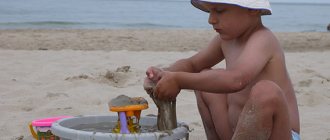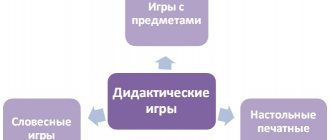Are you worried that your child won’t speak? Want to study at home, but don't know where to start? Are you planning to see a speech therapist? When a child aged 2.5 - 3 years has not begun to speak, you cannot do without the help of a speech therapist, but there is something you can do on your own. One of the main conditions for speech development is continuity, so it is important not only to study regularly with a specialist, but also to find time at home every day to do tasks to start speech. From this article you will learn about the most interesting and effective exercises that both adults and children will enjoy.
How do children develop the need to speak?
Speech therapists often advise parents to talk to their children more often, but not all mothers and fathers do everything right. Any language is a sign system, and a word, in fact, replaces a specific object, that is, it has a certain meaning. If communication between a child under the age of 1.5 years and his parents comes down to only manifestations of care and love, or the child prefers to play alone, then speech will not appear soon, even if quite a lot of words have been accumulated in the dictionary. For speech to appear, it is necessary that:
- the child needed to communicate with an adult: name an object, express feelings, ask for something;
- communication was meaningful: about toys, actions, impressions;
- adults talked to the baby for a reason, namely about joint actions, play;
- the child needed an object that had to be named in order to receive it.
When a baby finds himself in a situation of objective cooperation, he is faced with a speech task, and in order to solve it, he has to change his entire behavior.
The only way to get the desired item is only a verbal request, naming the item with a certain word. The only assistant here is an adult.
Speech therapists distinguish three stages in the acquisition of words by non-speaking children.
The emergence of a need for an item
These could be pictures, toys, cubes, books, clothes, treats, etc. The child wants to receive it, pulls his arms, tries to attract the mother’s attention with facial expressions and gestures. Sometimes unsuccessful attempts lead to crying and anger, but gradually the child understands that he can ask an adult for help.
Novikova-Ivantsova technique
The method of forming a language system (MFLS), developed by T. N. Novikova-Ivantsova, is applicable not only for all types of alalia, but for cerebral palsy and autism spectrum disorders. It is also suitable for children who have undergone cochlear implantation and have difficulties with the syllable structure of speech, the tempo and rhythm of speech, and the articulation of sounds.
The methodology is based on the ontogenetic principle of speech: from shouting to humming, from humming to babbling and speech. The initial stage of speech development is a cry, with its help small children aged from birth to 2-3 months react to any discomfort: pain, thirst, hunger. Healthy children scream loudly and loudly, with a short inhalation and a long exhalation. Babies with central nervous system pathologies, on the contrary, scream either too loudly or too quietly, and their cry sounds like sobbing. In severe cases, there is no cry at all.
Humming appears at the age of 3-5 months. Healthy children begin to chant, draw out vowel sounds, gradually adding consonants to them. Thus, the baby’s speech organs master the articulation of sounds. Humming has an intonation coloring, because with its help the child reacts to the speech of the parents.
Babies start babbling between 5 and 9 months of age. The child is able to repeat simple syllables of vowels and consonants many times, he listens carefully to spoken speech, and the duration of exhalation develops. Normally, by 10-12 months he can pronounce simple babbling words like “mama”, “baba”. One-year-old children should have about 10 babbling words in their active vocabulary. Gradually, by the age of two, children master phrasal speech.
The stages described are the foundation of speech development. If some stage “falls out,” for example, due to a serious illness, then it must be restored, otherwise the child will never speak. The Novikova-Ivantsova technique helps children go through the stages of humming and babbling again, master and improve the syllabic structure of words, and learn to pronounce two-syllable words and simple phrases.
MFYS classes are aimed at developing the speech apparatus and speech-auditory perception. At the initial stage, exercises on rhythm and the separation of non-speech and speech sounds are used. The correctional stage involves the development of complex non-verbal material, which involves fine motor skills and visual memory, so mastering the syllabic structure of a word occurs faster and better.
The key instrument that triggers the speech mechanism is music. It has been proven that children to whom their mothers sang songs in their native language in early childhood, as a rule, do not have problems with speech development. Each lesson in the Novikova-Ivantsova method corresponds to certain melodies.
We start talking while playing
Play is the leading activity for children; speech development is possible only through joint games and activities with an adult. Start with the simplest exercises so that the child can easily master them and constantly be in a situation of success.
Sounds and hands
Move your arms and legs and make a specific sound for each gesture. For example, we spread our arms to the sides and sing: “Ahhh”, put our palms to the corners of our mouth for “Uuuu”, put our feet shoulder-width apart for “Iiiiiii”, interlock our fingers and raise our hands above our heads for “Ooooh”, etc. .
Let's play ball
Sit on the floor with your child, spread your legs wide, throw the ball to the baby and say, “Let's play! Catch the ball, catch it,” emphasizing the verb “catch” with intonation. This way, you will encourage your child to say the word when he throws the ball back to you. Do the same when you roll the ball: “Roll the ball, roll!” The game should be emotional, so don't skimp on encouragement and praise.
"Alarm"
Children usually enjoy this exercise. Before performing it, it is advisable to make sure that the child has a rough idea of what a clock is. Say that now you will turn the baby into an alarm clock, and “wind up” him: make several circular movements with your finger on the child’s palm, stomach, head or back, saying: “tick-tock”, “tick-tock”. Now it should ring: shake your palm rhythmically, accompanying the movements with the sound “zzzzz”. Then suggest to your baby that you should be the alarm clock, and he should set you off. At first, help your child pronounce the necessary words and sounds; the more often you repeat the game, the faster he will remember these onomatopoeias.
"Train"
Stand with your child one behind the other, explain to your child that now you are train cars and will make many interesting journeys. Each family member can become a carriage in your train. As you move, make sounds like “tu-tuu-tu, chuh-chuh-chuh, tuuuu!”, encouraging your child to say them with you. While traveling around the apartment, comment on everything you see: “here is the washing machine, and here is the kitchen, now we’ll go to the nursery to get toys,” etc.
"Drip-drip-drip"
For this activity you will need a set of small colored dish sponges. Place two bowls on the table: one empty and the other with water, place sponges nearby so that the child can choose any one. Take one, wet it and squeeze it into an empty bowl, saying “drip-drip-drip.” Invite your child to do the same with other sponges.
"Bubbles"
This game helps the child learn to control his speech organs. You blow soap bubbles, and the child must pop them, simultaneously pronouncing paired sounds: “b” - “p”, “v” - “f”, “t” - “d” and others. Help your child by saying sounds with him.
"Talking Ball"
Take a small ball that fits in your palm, you can crochet it and fill it with rice or cereal, then it will gently massage children's hands. Transfer the ball from hand to hand and pronounce the sounds first (it is better to start with vowels and voiced consonants), and then, as the child masters the exercise, the syllables: KI-SA, MA-MA, BA-BA, DE-DA, etc. d.
Shoutout to the parents of a non-speaking child
As a result of such conversations, recommendations were drawn up for parents whose children cannot speak for a long time.
Tips for parents
- Talk to your child more, voicing all actions (feeding, dressing, bathing), commenting on the environment, not being afraid of repeating the same words, pronounce them clearly, patiently, and kindly.
- Develop understanding of speech using simple instructions such as “Give me a pen”, “Where is the leg?” Rely on what is available to the child. Repeat what you have already learned over and over again.
- In speech, use their simplified versions along with full words: car - beep, doll - la-la, fell - bang.
- Sing to your child before bed. It's better not to change your repertoire often.
- Create a desire to imitate an adult. This is possible when emotional interest and accessibility of words that the child pronounces during joint games are combined (Hide and Seek - peek-a-boo, Little Engine - tut-tu). You can be surprised together by what you see: “Wow!” The first words spoken against an emotional background can be interjections: oh, ah, uh. The child is allowed to repeat only vowels: o, a, u.
- Tell stories and read children's first fairy tales and poems more often. Encourage the child to complete the words to the best of their ability.
- Do not overload your child with television, video and audio information. When reading, reduce the text to understandable phrases.
- Do not talk in front of your child about his retardation.
- Don't be annoyed or embarrassed by what your child doesn't say. Do not show excessive anxiety: everyone has their own deadlines and their own problems.
- Without waiting for the child to speak. Start teaching him to distinguish objects by size (large - small); match colors, shapes (give me the same); quantity (one - many).
- Massage your fingers and palms, play games like “Magpie-White-sided”.
“My first words” by N. A. Shishkina
This method of starting speech in non-speaking children is also based on the principles of developmental education and the unity of educational, training, development and correctional goals. The emergence and development of speech occurs as a result of the child’s various activities. First, the baby masters vowel sounds, and then adds consonants to them, the order of learning is from simple to complex.
To study each sound, you are given as much time as necessary in this particular case. The speech material of the technique was developed and tested by N. A. Shishkina over ten years. It is presented in the author's workbook “My First Words.” This manual is suitable for both children who more easily learn the sound characteristics of speech, and for children who are better able to understand the syllabic characteristics of speech.
It is recommended to start practicing according to Shishkina’s method from an early age.
How to work with a non-speaking child using Shishkina’s benefits? The first step is to elicit a vocal response to vowel sounds. Then it is important to teach the child to repeat words after an adult in the most convenient form for him; here the quality of pronunciation does not matter, since the main goal is to expand the vocabulary. N.A. Shishkina, who recommends adhering to the following rules:
- An adult’s speech should be emotional and consist of clear, specific instructions and explanations such as “show”, “hide”. It is advisable to accompany words with gestures and facial expressions, since for speechless children such “language” is most understandable.
- All actions are performed from left to right and from top to bottom, this subconsciously accustoms the child to reading and writing, albeit in the distant future.
- There are only six pictures on the sheet, which corresponds to the visual perception of a preschool child. The order of naming the pictures must be changed every lesson.
- The adult first completes each task himself, then either the child repeats the exercise independently or with the help of an adult.
Practicing each task consists of four exercises, which are called:
- “Picture-symbol” introduces the child to sound and helps create a play situation;
- “Magic Buttons”, an exercise aimed at eliciting a vocal response. Multi-colored square buttons are “pressed” with the index finger, and the sound is pronounced only once;
- "Soundtracks". Here the child needs to attach the sticker to the desired square. Then, running his finger along the path, the child pronounces the syllable.
- “Say the words with the sounds you are learning.” The adult selects the desired sticker, reads the word, then asks the child to place the sticker where it should be, name the sound and circle the corresponding letter with a pencil.
On average, you need to use two stickers per practiced sound per lesson. Gradually the tasks become more difficult.










